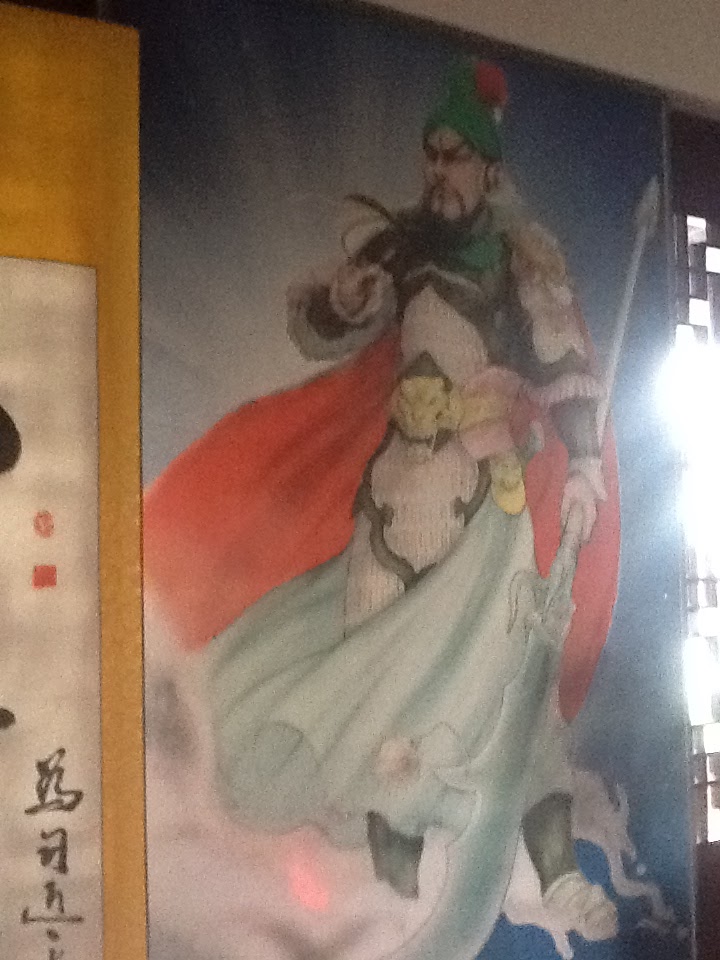After I left work today, I went for a walk around Hankou. I finished by noon, so had the rest of the day to look around.
I wandered through some shopping streets. There are some bronze statues to iconic Wuhan people along a pedestrian street there. There is an iconic "stick man" who are pole bearing laborers you can still see around today. Basically, if you have a stick and a strong back, you can make some sort of living moving things around Wuhan.
The front steps go down to the river.
Great decorations on the outside of the temple.
Buddha image on the second floor. Directly over the statute of the Dragon King on the second first floor.
View down the main staircase entering the temple.
The confluence of the Chang Jiang and Han Piang rivers.
The view from Hankou across to Wuchan.
I believe this is an image of the Dragon King in his Dragon form. My friend identified the name of the dragon, for whom the temple was built to be Nanhai.
Another image of the wicked spear wiedling Guan Gong, protector of the buddhist faith.
Looking down from the stairs to the statue of the Dragon King. Not the odd horn like appendages protruding from his brow.
Wood carving of Guanyin. This carving was located just inside the main door of the temple.
Great painting details through the outside. I noticed one woman, hand washing above the sills of the windows on the outside of the temple.
I wandered through some shopping streets. There are some bronze statues to iconic Wuhan people along a pedestrian street there. There is an iconic "stick man" who are pole bearing laborers you can still see around today. Basically, if you have a stick and a strong back, you can make some sort of living moving things around Wuhan.
There is also a statue of Bao Li, the inventor of the famous "hot and dry noodles" or Ragemian. In the early of 1930s, there was a small
restaurant operated by Bao Li, who made a living by selling bean noodles and
noodle soup near a temple in Hankou. One day, by accident, he spilt sesame oil
onto his noodles. The next day, he eventually boiled those noodles and added
shallot and other condiments. Next morning, his noodles soon became very
popular because of its unique taste. Many people ask Bao Li what kind of noodle
it is, Bao Li answered: Hot dry noodles.
I eat alot of Ra Ga Mian. It is very tasty. You can buy good ragemian for maybe 4 kuai (.75 USD).
I walked all the way to the Yangtze river. There was a temple I had not gone to, so I decided to stroll down that way.
I did not know what temple it was, but have subsequently found out it was the House of the Dragon King.
A long time ago, the people in the area needed rain. So they decided to ask for help from a friendly dragon who lived in the Chang Jiang (Yangtze).
To create better relations with this dragon, they built him a nice house and remember him with a big statue and alot of donations.
Chinese dragons are benevolent. They are associated with the ocean or bodies of water. The Dragons can appear as a flying serpent or as a human. They are associated with rain and water.
The Dragon king has two interesting horn like appendages protruding from his head.
Chinese temples are especially fascinating because you have a mix and match approach. Just inside the door was a wooden carving of the buddhist goddess of mercy, Guanyin. Flanking her carving was another of a blissful buddha and a huge dragon.
The Dragon God himself is basically a folk or Taoist pantheon god.
On the second floor of the temple, there is a statue of Shakyamuni buddha directly above where the statute of the Dragon King is on the second floor. There were many examples of calligraphy and paintings on the second and third floors. There was an image of Guan Gong adjacent to the Buddha statue on the second floor. Guan Gong is a historical general who is now revered as a sort of buddhist protector. In the Jingzhou temple of Guan Gong, the monks or devotees had recorded chanting along the lines of mantra, revering Guan Gong's name.
China has a uniquely syncretic religious culture that allows the intermingling of religious images and meaning between what are completely distinct religious traditions. This I find to be quite fascinating.
The house of the Dragon King has great views of the Han Jiang and Chang Jiang confluence.
A nice place to take a look around, but certainly more for locals and devotees.
The front steps go down to the river.
Great decorations on the outside of the temple.
Buddha image on the second floor. Directly over the statute of the Dragon King on the second first floor.
View down the main staircase entering the temple.
The confluence of the Chang Jiang and Han Piang rivers.
The view from Hankou across to Wuchan.
I believe this is an image of the Dragon King in his Dragon form. My friend identified the name of the dragon, for whom the temple was built to be Nanhai.
Another image of the wicked spear wiedling Guan Gong, protector of the buddhist faith.
Looking down from the stairs to the statue of the Dragon King. Not the odd horn like appendages protruding from his brow.
Wood carving of Guanyin. This carving was located just inside the main door of the temple.
Great painting details through the outside. I noticed one woman, hand washing above the sills of the windows on the outside of the temple.



















